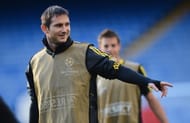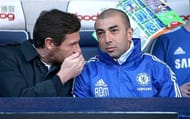Evolving from the unconventional 4-2-4 formation used in Brazil, way back in the 50s and the 70s, the 4-2-3-1 formation was practiced and then perfected through extensive use during the early 1990s, especially in countries like Spain and France. Although perceptually defensive, the formation strikes a near perfect balance with a six man defense and a six man attack tactical layout.
With a trio of attacking midfielders playing just behind the lone forward, helped by the marauding full-backs, this is a setup where one shouldn’t be actually complaining about the lack of service. However, the linchpin of the formation is it’s emphasis to control the midfield and thus the possession; invariably pointing towards the two man partnership at the centre of the pitch, forming the ‘double pivot’.
The pivot essentially plays a dual role – a perfect blend of attack and defense – and hence goes on to provide the so called balance into the setup. With a heavy striking force operating at the higher end of the pitch, the double pivot consists of generally two defence minded midfielders, compensating for the otherwise “one man missing” midfield. They would help in repelling opposition attacks by tackling, heading and marking players, employing either of zonal or man marking tactics; thus assisting the back-line behind and restoring the overall stability. However, the final link in the puzzle is the ability of either of the duo to initiate attacks from the deep; possessing a vast range of passes and providing the all important “second to final” balls and effectively transforming the team into a virtual “12 man” engine!
Now, putting things into perspective, let us shift our attention to Chelsea. When the Blues lifted their holy grail this May, one felt that a summer overhaul was just around the corner, with the Russian owner seemingly expanding his ambitions of maintaining a sustained period of success. And so it proved to be, as the club signed a range of skillful yet technically sound, nimble footed attacking midfielders in the form of Eden Hazard, Oscar and Marko Marin.
And while the fans were merely contemplating in the build up to the season, all doubts were erased by September as Roberto Di Matteo indeed shaped up the team under the much talked about and his preferred 4-2-3-1 formation. With a flurry of wingers and advancing midfielders available at his disposal, filling up the trio behind the lone striker was never a problem. Chelsea had even the option of resorting to the likes of Ryan Bertrand and Ramires in the extreme of circumstances. As for the regular purpose, the dynamic trio of Eden Hazard, Oscar and Juan Mata made the positions as their own very soon into the year.
However the problem was slightly “deeper” , quite literally that is, inside the all important double pivot. With the departure of Michael Essien on loan to Real Madrid and the final minute “bandage signing” last year Raul Meireles moving to Fernabache, Chelsea’s options were limited to John Obi Mikel, Frank Lampard and the Brazilian Ramires (who was too initially preferred on the right by the current manager).
Mikel, being a traditional defensive midfielder, and neat in possession (Yes ‘neat’ and I mean it; despite his Juventus error) was an automatic choice in one of the two positions but who could have been the second one? Well, Frank Lampard, one of the best midfielders of the past decade, would sound the obvious preference and so he was for Di Matteo. However, when Atletico Madrid seemingly bulldozed Chelsea in the Super Cup encounter late August, the deficiencies of the duo were exposed – Frank Lampard being the centre of the criticism.
At 33, he wasn’t getting any younger and there were frantic calls on his career, some suggesting that the former West Ham man had lost his past touch. However, delving a bit deeper, one would realize exactly why this argument was nothing short of an epic fail.
Frank Lampard was a great footballer and he still is! He is simply a victim of an acute case of the “right man in a wrong setup”. The Englishman is a traditional box to box midfielder, whose natural instinct is to go forward and be at the right spot at the right time to bury in the goals from in and around the penalty area. Now in a 4-2-3-1, Lampard’s luxury of going forward is effectively cut off; restricting it to only distributing the ball from deeper areas of the pitch (which to be honest isn’t one of Lampard’s fortes). To make matters worse, defensive tackling and marking opponents is again something you wouldn’t associate with Lampard. So basically in the pivot, he is entrusted with two aspects that are completely alien to him!
So when the duo was put into the field, Frank, unable to curb his natural instinct, ventured out far too often, leaving Mikel alone at the centre of the park. And his ageing legs weren’t quite suitable for tracking back either. With the Nigerian being ‘traditionally’ slow with his movements himself, Chelsea’s midfield were time and again reduced to nothing less than simply a vacant space at the centre of the park, an aspect which was brutally exploited by Falcao and co. via pacy counter-attacks during the Super Cup encounter; and partially by Shakhtar Donetsk in the Champions League tie last night.
Ramires, on the other hand, was a relatively safer bet. Although, the Brazilian made minimal impact offensively from the pivot with his “remarkable inability” to pass, he provided an insurance policy for Chelsea defensively. Despite his own ventures forward by running down with the ball, his breathtaking pace meant he could track-back with ease, restricting the counter attacks; and thus assisting Mikel in the midfield.
However, in any case, with a semi-dysfunctional pivot, the Blues were and are still unable to make utmost utilization of the 4-2-3-1 formation. Ideally, someone like Luka Modric, Andrea Pirlo, Xabi Alonso or even Nuri Sahin is exactly what Chelsea needs – someone who knows his defensive duties yet has a vast range of passes and can distribute balls – to play alongside Mikel. However, with their availability being unrealistic in the market, or for that matter anyone in this sort of mould, Chelsea are certainly not spoilt for choices!
Di Matteo doesn’t even have much of a ‘realistic’ scope of filling up the pivot with an “idealistic choice” during the transfer market
In the midst of all the discussion, we forgot about a certain Oriol Romeu who was initially brought in as a back up to Mikel from Barcelona on second thoughts, can one consider him as an option? Well, no harm in pondering upon it.
For starters, Romeu is defensive minded and is a strong tackler. But what stands out for him, is his ability to pass the ball and his fairly agile movements; especially given his ‘heavy’ physique. Perhaps one of the faces of the AVB era, Romeu hasn’t quite been featuring in the side since the former Porto man’s departure. However, the little we saw of him during that period, one can certainly derive the above mentioned qualities from it; which in turn, at least “theoretically”, makes him a suitable pick for the pivot alongside Mikel and not merely a “back-up” for him, especially when you cite his solid yet fluid displays against Wolves at home and Newcastle away last season.
Although still untried by Di Matteo, I for one will be particularly thrilled to see this very combination. After all, it is all about weighing up your options and who knows what you can end up with!
Moving on, Chelsea’s options might again be vastly opened by the return of injury prone Marko Marin. Apparently under a strict regime, Marin has had a vast improvement in his physique, with Chelsea staff determined to restore his past abilities for which he was once termed as the “German” Messi.
According to Marlin, a season ticket holder at Chelsea and an associate of a Chelsea portal called “VitalChelsea”, –
“Roberto Di Matteo has taken a note on the injury map of Marko for the last three years. He is carefully getting the player to slowly work with the Chelsea Medics.
Marin has been put on a strict diet and has drastically lost a lot of weight..he is training alone with Greg Strommier, a development trainer. He trains with bands on shoulder hips and knees every day for a 5 hour period and stays in a ice room.Marin is slowly getting his shape and weight; his diet is taking control. His calf and hamstring are in a better shape. His overall physique has improved. The date of return isn’t definite but behind the scenes the manager and club are waiting intently, cause given the fixture schedule packing till the new year, Marin might be an impossible asset to miss.”
So, with so much anticipation regarding Marin’s return already, one couldn’t just rule out a new possibility this might bring with regards to the double pivot situation. The German can be employed in the current “Oscar role”, inside the hole behind the striker, which would in fact be the best possible option for him as a player. And in return the Brazilian can be entrusted a deeper role than his usual “number 10″, effectively in the pivot. The Brazilian has a stupendous work rate which would enable him to provide the ‘defensive cover’ and his fantastic vision has already been there to see for all. So, again very much on ‘theoretical grounds’ Oscar in the double pivot might well be an apt option.
Roberto Di Matteo has his work cut out and as much as the fans are crying out for a new striker, it is the double pivot that is the last missing link in the Chelsea puzzle – something which needs thorough attention.


